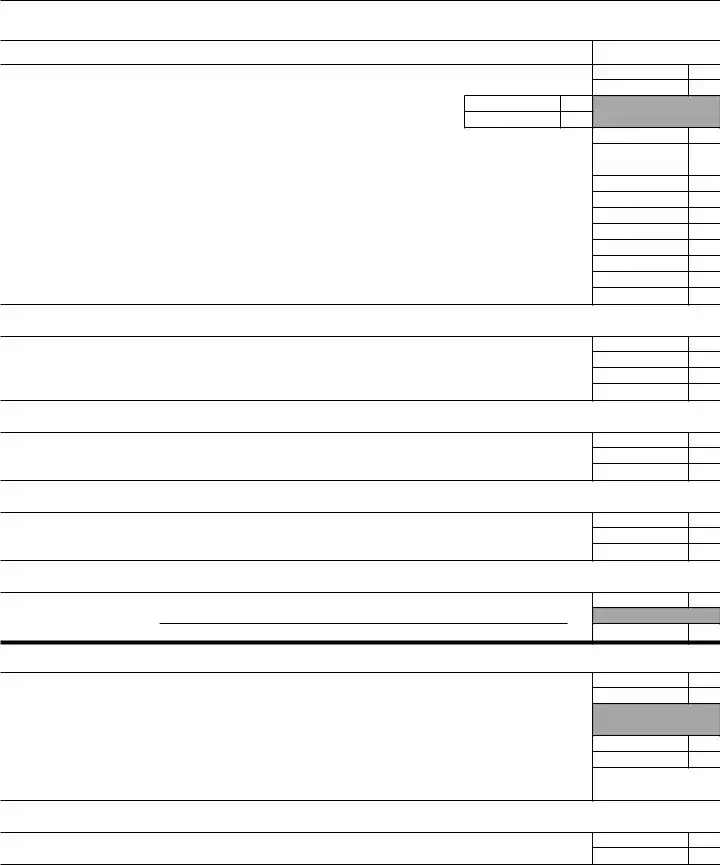The United States federal Form 1065, Partnership Income Tax Return, closely resembles Kentucky's Form 765 in its purpose and content. Both serve partnerships needing to report their income, deductions, and the distribution of shares to their partners. Each form requires the partnership to attach a copy of the other financial documents, like depreciation schedules and K-1 forms, to provide a comprehensive account of the fiscal activities. Where Form 1065 addresses federal requirements, Form 765 satisfies Kentucky's state-specific stipulations, making them parallel tools for tax reporting at different governmental levels.
Form 4562, Depreciation and Amortization, is cited in both the federal Form 1065 and Kentucky's Form 765, underlining their similarity in demanding detailed accounts of depreciation expenses. These forms necessitate a precise enumeration of assets, the calculation of depreciation for tax purposes, and adjustments specific to respective jurisdictions. The inclusion of Form 4562 in the documentation process highlights the shared requirement for businesses to systematically report the depreciation of their assets, facilitating a uniform approach to tracking the declining value of business investments over time.
Kentucky's Schedule K-1 (Form 765) mirrors the federal Schedule K-1 (Form 1065) in its utility and function. Both are designed to report the share of income, deductions, credits, etc., passed through to partners or members of partnerships or limited liability companies treated as partnerships for tax purposes. They ensure that the income earned and taxes paid at the partnership level are accurately reported and allocated to the individual partners, so they can report their shares on personal tax returns, thereby seamlessly linking partnership activities with individual tax liabilities.
The Kentucky Department of Revenue Form 720, the Corporation Income Tax Return, and Form 765 share a fundamental similarity in their roles as state-level tax documents catering to different business structures – corporations vs. partnerships. They both demand detailed financial reporting, including income, deductions, and tax calculations pertinent to their respective entities. While their specific formats and requirements reflect the unique characteristics of the entities they serve, the overarching goal to report and calculate Kentucky state tax liabilities unites them.
The IRS Form 4797, Sales of Business Property, is similar to sections within Kentucky's Form 765 that deal with the reporting of gains or losses from the sale of assets used in a business. Both require detailed information about the sale or exchange of property and play a pivotal role in adjusting the income subject to taxation, reflecting the interconnectedness of asset disposition and taxable income for businesses. This common feature underscores the necessity for businesses to account for and report significant changes in their asset bases for tax purposes.
Form 4562, Kentucky's counterpart for reporting depreciation adjustments specific to state tax codes, shares its framework and intent with the federal Form 4562, underscoring its relevance in both federal and state tax preparations. This similarity highlights the intricate relationship between depreciable asset reporting and tax liability adjustments, catering to the nuanced modifications that state-level considerations infuse into the broader, nationally standardized depreciation calculations.
IRS Form 1065-B, U.S. Return of Income for Electing Large Partnerships, parallels Kentucky's Form 765 in targeting a specialized subset of partnerships – those that are large and elect out of certain standard treatment. Although specific in their focus, both forms mandate comprehensive disclosures of income, gains, losses, deductions, and credits, reflecting the enhanced reporting obligations incumbent upon larger partnerships. These forms reflect the heightened complexity and scrutiny directed at large partnership entities across both federal and state tax landscapes.
Kentury Schedule UTC, Unemployment Tax Credit, which may accompany Form 765, is akin to various federal incentives aimed at encouraging specific business behaviors, like the Federal Work Opportunity Credit. Each is designed to alleviate the tax burden on businesses contributing positively to broader economic or social goals, such as employment growth. By providing detailed mechanisms for claiming these benefits, both Kentucky and the federal government align on the principle of using tax policy to incentivize beneficial business practices.
The Recycling and Composting Equipment Tax Credit Schedule, attachable to Kentucky Form 765, demonstrates a targeted approach to environmental stewardship through tax incentives, a concept mirrored in various federal tax credits aimed at promoting sustainability. These pieces of the tax code encourage investments in environmentally friendly practices by offering financial benefits for compliance, illustrating the shared use of tax policies to drive investment in priority areas across different levels of governance.
The form for the IRC Section 179 expense deduction, required alongside both federal and Kentucky tax returns for businesses, illustrates the alignment in taxing authorities' efforts to stimulate business investment in machinery and equipment. By allowing upfront deductions of such purchases, both the IRS and the Kentucky Department of Revenue aim to lower the fiscal barrier to capital investment, fostering an environment conducive to business growth and modernization, underscoring their shared focus on economic development through tax policy.


